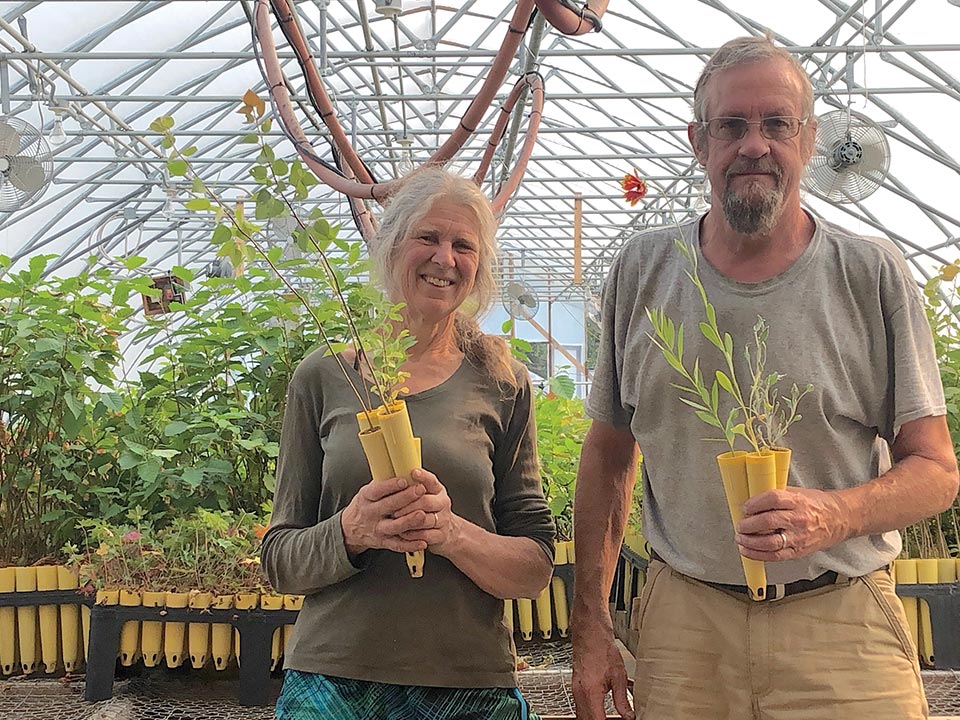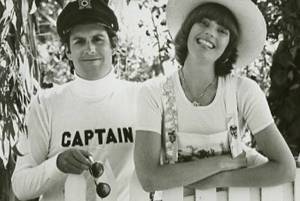By DIANNA TROYER
The season of seed-gathering is in full swing for Jim Crawford and Margo Conitz, who patiently pluck, sort, and clean countless native plant seeds for their Twin Peaks Native Plant Nursery in western Idaho. From late August to November, they temper their painstaking task with humor.
“Gotta get some conifer cones before the squirrels get them all,” Conitz joked. “The fall colors are gorgeous when we’re gathering, but, like all our favorite things, it doesn’t last long enough.”
They envision how the seeds will germinate in spring in their 4,000-square-foot, climate-controlled greenhouse south of McCall.
Sprouting dogwood seeds look like frog eggs, a soup of round brown spheres the size of tapioca. As tiny shrub seedlings sprout and push off their seed cap, they look like characters in a Dr. Seuss book.
In full bloom, the greenhouse becomes a living landscape painting of colorful wildflowers—Indian paintbrush, rosy pussytoes, pearly everlasting, scarlet gilia, purple monkey flower, yellow and blue columbines, balsamroot, red and purple penstemons, sticky purple geranium and mallows.
Since 1994, companies and government agencies have been relying on their nursery to provide native plants of the Intermountain Northwest for habitat restoration. The nursery is a premier provider of perennial wildflowers, wetland and upland grasses, conifers, trees, and shrubs.
“Our plants are used for habitat improvement, mining reclamation, erosion control projects, and campground improvement,” Crawford said. “We’re also a source to landscapers and other nurseries for native plants.”
They strive to match up seed sources, elevations, and soil types to produce plants best adapted to certain sites.
To help their plants absorb nutrients, “we inoculate seedlings with species-appropriate mycorrhizal fungi,” Conitz said. “The plants carry that association into the field, giving them an advantage when planted in harsh sites.”
While native plants are used for restoration projects, they are also becoming popular with consumers who want beautiful, drought-tolerant plants in their yards. In some areas, thirsty lawns are being replaced with low-maintenance native perennials.
“Several cities in Utah require residents to grow native plants for landscaping, to conserve water,” Crawford said.
Fortunately for the couple, their original business plan for a nursery took a detour decades ago. Instead of growing conifers, they gambled on supplying the native plant and shrub market and found their niche.
“We originally thought we’d set up a greenhouse to grow conifer trees for reforestation but realized it was such a competitive market,” Crawford said. “We chose to pursue the native plant market instead.”
Conitz recalled their first growing season.
“We had a demand for our crop of local native shrubs for fire restoration near McCall,” she said. “Things built from there.”
To keep up with demand, they rely on their greenhouse and also a 10,000-square-foot fenced area for large containers. They hire three or four seasonal part-time employees during the spring planting season and during the fall packing season.
As they gather seeds, they find one of their favorite shrubs, the russet buffalo-berry and original namesake for their business, Buffalo Berry Farms. (Native Americans picked buffalo berries for medicinal purposes and whipped the berries with water to make a frothy dessert.)
They recently changed the name to Twin Peaks Native Plant Nursery “because so many people mistakenly thought we were a you-pick berry farm,” Conitz said.
In the past few months, they have seen increased interest from government agencies and consumers in plants that attract pollinators.
“Rabbit brush is a late flowering plant, so people like it because it provides flowers for pollinators throughout the fall,” Conitz said. “It doesn’t need a lot of water, either.”
With increased awareness and concern about water quality and fertilizer and herbicide runoff into Payette Lake, they encourage homeowners to plant the nursery’s wetland grasses and riparian shrubs as a buffer between their yards and the lake.
During autumn, when they’re not dealing with seeds, they ship plants—lodgepole pine, snow buckwheat, spiny hopsage, bitterbrush, sagebrush, and countless others.
Looking over the plants in their greenhouse, Conitz said, “It’s gratifying to know our plants are being used for many purposes, especially helping to restore wild areas.”
Crawford said, “We enjoy working with our agency friends on their projects and showing individuals and groups the process of growing plants started from native seed. There are lots of good folks interested in native plants on all levels.” ISI










